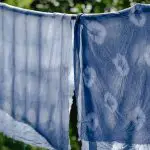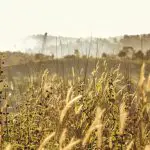Lawn fabrics are materials you lay over soil to block weeds, retain moisture, and boost plant health by letting water and air through. You’ll find natural, synthetic, or blended options, each with unique benefits like breathability or durability. They work by stopping sunlight from reaching weed seeds, cutting down your garden upkeep. Proper installation and mulching can extend their life. If you want to make the most of lawn fabrics, there’s more helpful info you can explore.
Table of Contents
Key Takeaways
- Lawn fabrics are protective barriers laid over soil to control weeds by blocking sunlight and preventing seed germination.
- They allow water and air to pass through, maintaining soil moisture and promoting healthy plant growth.
- Lawn fabrics can be natural, synthetic, or blended, offering varying breathability, durability, and UV protection.
- Proper installation involves soil preparation, securing edges, overlapping seams, and covering with mulch to enhance effectiveness.
- Using breathable and recyclable fabrics minimizes environmental impact while supporting soil health and reducing chemical use.
Definition and Purpose of Lawn Fabrics
Lawn fabrics act as a protective barrier that helps you control weeds and maintain soil moisture in your garden. When you lay these fabrics over your soil, they block sunlight from reaching weed seeds, preventing them from sprouting.
At the same time, they allow water and air to pass through, ensuring your plants get the moisture and oxygen they need. This balance helps your garden thrive without the hassle of constant weeding or overwatering.
You’ll also find that lawn fabrics reduce soil erosion by stabilizing the ground during heavy rains. By using them, you create a healthier environment for your plants and save time on maintenance.
Types of Lawn Fabrics Available
You’ll find lawn fabrics come in three main types: natural, synthetic, and blended.
Each type offers unique benefits depending on your needs and preferences.
Let’s explore what makes each one stand out.
Natural Lawn Fabrics
Natural fibers like cotton, linen, and silk create some of the most breathable and comfortable lawn fabrics you’ll find.
These materials are prized for their softness, natural sheen, and ability to keep you cool in warm weather.
When you choose natural lawn fabrics, you get durability combined with a gentle touch on your skin.
Here are three popular natural lawn fabrics you might consider:
- Cotton Lawn – Lightweight, smooth, and easy to work with; perfect for everyday wear.
- Linen Lawn – Crisp and slightly textured, it offers excellent breathability.
- Silk Lawn – Luxurious with a subtle shine, great for special occasions.
Using these fabrics means enjoying natural comfort and elegant style without sacrificing quality.
Synthetic Lawn Fabrics
When selecting fabrics, synthetic options offer versatility and durability that suit various needs.
You’ll find popular synthetic lawn fabrics made from polyester, nylon, and acrylic. These materials resist wrinkles, fading, and moisture, making them ideal for outdoor use.
Polyester’s strength and color retention keep your lawn looking fresh season after season. Nylon adds excellent elasticity and resistance to abrasion, perfect if you want a fabric that endures heavy foot traffic.
Acrylic mimics the softness of natural fibers but dries quickly and resists mildew, so it’s great if you’re in a humid climate.
Choosing synthetic fabrics means you get low maintenance and long-lasting performance. Plus, many come treated for UV protection, ensuring your lawn fabric stays vibrant under the sun.
Blended Lawn Fabrics
Blended lawn fabrics combine the best qualities of different fibers to deliver enhanced performance and comfort.
When you choose blended fabrics, you get a balanced mix that leverages the strengths of each fiber, making them versatile for various uses. For example, blends often combine natural fibers like cotton with synthetics such as polyester to improve durability and reduce wrinkling.
Here are three benefits you’ll appreciate with blended lawn fabrics:
- Durability – They resist wear and tear better than single-fiber fabrics.
- Breathability – Blending maintains airflow, keeping you comfortable in warm weather.
- Easy Care – These fabrics are usually wrinkle-resistant and easy to wash.
How Lawn Fabrics Work to Control Weeds
Although lawn fabrics might seem simple, they play an essential role in controlling weeds by blocking sunlight and preventing weed seeds from germinating.
When you lay lawn fabric over your soil, it forms a physical barrier that stops weed seeds from accessing the light they need to sprout. This means fewer weeds grow, so you spend less time pulling them out.
The fabric also allows water and nutrients to pass through, so your lawn and plants still get what they need while weeds struggle to survive.
By using lawn fabrics, you effectively reduce weed growth at its source, making your gardening efforts more efficient and your lawn healthier.
Using lawn fabrics cuts weed growth early, boosting your garden’s health and ease of care.
It’s a straightforward way to keep weeds in check without relying heavily on chemicals or constant maintenance.
Benefits of Using Lawn Fabrics in Your Garden
Because lawn fabrics block weeds while letting water and nutrients through, they offer several key benefits that make your gardening easier and more effective.
When you use lawn fabrics, you reduce the time and effort spent on weeding, helping your plants thrive without competition. Plus, these fabrics improve soil moisture retention, so your garden stays hydrated longer, especially during dry spells.
Finally, they help maintain soil temperature, protecting roots from extreme heat or cold.
Here are three main benefits you’ll enjoy:
- Less Weeding: Spend less time pulling weeds and more time enjoying your garden.
- Better Moisture Control: Keep your soil consistently moist, reducing the need for frequent watering.
- Soil Protection: Shield roots from temperature fluctuations to promote healthy growth.
Choosing the Right Lawn Fabric for Your Needs
How do you pick the best lawn fabric for your garden? First, consider your main goal: weed control, moisture retention, or soil protection. Next, think about the fabric’s durability and breathability. Lightweight fabrics suit seasonal use, while heavier ones last longer. Finally, check if the fabric is UV resistant for extended outdoor exposure.
| Fabric Type | Best For |
|---|---|
| Lightweight | Seasonal weed control |
| Medium weight | Moisture retention and weeds |
| Heavyweight | Long-term soil protection |
Choosing the right fabric means matching it with your garden’s specific needs. This guarantees your plants thrive and maintenance stays minimal.
Installation Tips for Lawn Fabrics
Once you’ve selected the right lawn fabric, the next step is installing it properly to guarantee it performs well.
Start by preparing the area—clear debris, weeds, and smooth the soil for a flat surface. Next, lay the fabric tightly to avoid wrinkles that can trap moisture and cause mold. Secure the edges with landscape staples or pins to keep it in place during wind or rain.
Here are three key tips:
- Overlap fabric edges by 6-12 inches to block weed growth effectively.
- Cut holes only where plants will grow, minimizing exposed soil.
- Cover the fabric with mulch or gravel to protect it from UV damage and enhance appearance.
Following these steps assures your lawn fabric lasts and works efficiently.
Maintenance and Longevity of Lawn Fabrics
Although lawn fabrics are designed to be durable, regular maintenance is essential to extend their lifespan and keep your garden looking neat.
You should routinely check for debris like leaves and dirt that can accumulate and cause mold or hinder water flow. Make certain to keep the fabric taut and repair any tears promptly to prevent weeds from sneaking through.
Avoid walking on the fabric too much, as excessive pressure can degrade its fibers. During seasonal changes, you might want to remove the fabric temporarily to clean and inspect it thoroughly.
Proper maintenance not only boosts longevity but also guarantees your lawn fabrics perform effectively, providing a strong barrier against weeds while promoting healthy soil and plant growth.
Common Mistakes to Avoid When Using Lawn Fabrics
Keeping your lawn fabric in good shape takes effort, but even the best maintenance won’t help if you fall into common usage traps.
Maintaining lawn fabric requires care—avoid common pitfalls to ensure lasting effectiveness.
Avoid these mistakes to get the most out of your lawn fabric:
- Skipping Soil Preparation: Don’t lay fabric over uneven or rocky soil. You’ll get poor weed control and potential tears.
- Neglecting Proper Anchoring: Failing to secure the fabric firmly lets wind and movement cause damage or expose soil.
- Covering with Improper Mulch: Use only recommended mulch types; heavy or sharp materials can rip the fabric, shortening its lifespan.
Environmental Impact of Lawn Fabrics
When you choose lawn fabrics, it’s important to contemplate how they affect the environment. Many fabrics are made from synthetic materials like polypropylene, which don’t biodegrade and can contribute to plastic pollution if not disposed of properly. You can reduce this impact by selecting fabrics that are recyclable or made from recycled content.
Also, consider how lawn fabrics influence soil health; some block water and air flow, potentially harming beneficial organisms. Using breathable options helps maintain a healthier ecosystem beneath your lawn.
Finally, think about the lifespan of the fabric. Choosing durable materials means less frequent replacement, reducing waste over time. By being mindful of these factors, you can enjoy the benefits of lawn fabrics while minimizing their environmental footprint.
Frequently Asked Questions
Can Lawn Fabrics Be Used Under Patios or Walkways?
You can use lawn fabrics under patios or walkways to prevent weed growth and improve drainage. Just make certain to choose a durable, heavy-duty fabric designed for high traffic areas to guarantee long-lasting performance.
Are Lawn Fabrics Safe for Pets and Children?
When your little explorers roam, lawn fabrics gently guard the ground beneath their feet. They’re generally pet- and kid-friendly, but you should double-check labels to avoid any hidden surprises and guarantee a safe, happy playtime.
How Do Lawn Fabrics Affect Soil Moisture Levels?
Lawn fabrics help retain soil moisture by reducing evaporation and preventing weed growth, so you won’t need to water as often. Just make sure the fabric allows some water and air to reach the roots for healthy plants.
Can Lawn Fabrics Be Reused After Removal?
Yes, you can reuse lawn fabrics after removal if they’re still in good condition. Just clean off dirt and debris, let them dry, and store them properly to maintain their durability for future use.
Do Lawn Fabrics Interfere With Lawn Mowing or Edging?
When it comes to lawn mowing or edging, lawn fabrics usually don’t throw a wrench in the works. Just make sure they’re secured properly, so they won’t shift or get caught in your mower blades.
- Does Chiffon Fabric Stink - July 15, 2025
- Does Chiffon Fabric Affect the Economy - July 15, 2025
- Does Cotton Fabric Have a Nap - July 15, 2025







